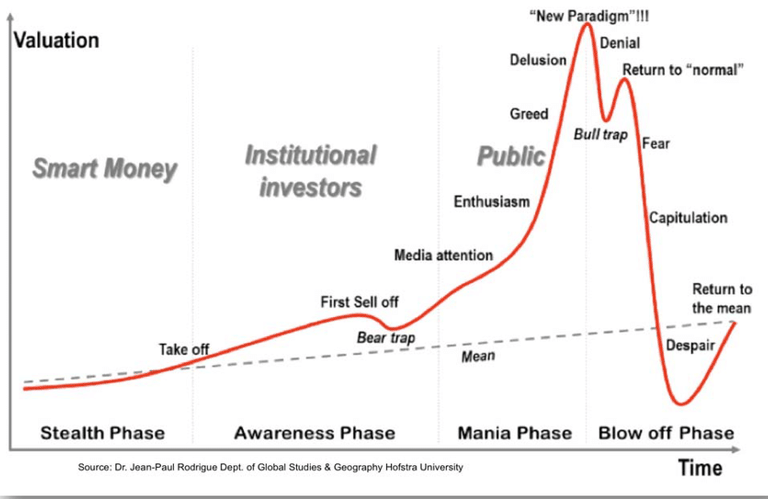The Market Cycle

Market Cycle Stages:
1. Unbelieve that the Market is Going Up
Picture this: the market has been in a slump for a while, and everyone is feeling pretty down about it. Suddenly, there's a tiny glimmer of hope—prices start to creep up. But wait, is this for real? Most people are skeptical. This stage is all about disbelief. Investors are hesitant to jump back in because they're not convinced this upward trend is here to stay. It's like seeing the first few blossoms in spring—you want to believe winter is over, but you're not quite ready to put away your coat just yet.
2. Believe
As prices continue to rise, more and more investors start to think, "Hey, maybe this is for real!" This is the stage where belief starts to kick in. People begin to buy back into the market, cautiously at first. It's like dipping your toes in the water before taking the plunge. Positive news and economic indicators help fuel this newfound confidence. The mood is shifting, and the market is starting to look a lot sunnier.
3. Over Believe in Investors' Decisions - Aggressive Moves
Now that the market has been climbing steadily, investors start to get a little too confident. This is the stage of overbelief, where decisions become more aggressive. It's like going from dipping your toes to doing a cannonball into the deep end. Investors start to take bigger risks, convinced that the market can only go up from here. The optimism is contagious, but it's also a sign that caution might be getting thrown to the wind.
4. Greed and Euphoria: Mania, Craziness & Irrational Decisions
Welcome to the euphoria stage—where things get a little crazy. The market is on fire, and everyone wants in on the action. Prices are skyrocketing, and it feels like there's no way they could ever come down. This is the stage where greed takes over. Investors are making irrational decisions, driven by the fear of missing out (FOMO). It's like a wild party where no one thinks about the hangover that might follow. People are buying anything and everything, convinced that the market is a one-way ticket to riches.
5. Panic
And then, just like that, the bubble bursts. Something triggers a sell-off, and prices start to plummet. Panic sets in as investors scramble to get out before things get worse. This is the stage where fear takes over, and rational thinking goes out the window. It's like waking up the morning after that wild party and realizing the mess you've made. People are selling at any price they can get, and the market turns into a freefall.
6. The Bull Trap
Just when it seems like the market is starting to stabilize, a bull trap lures investors into a false sense of security. Prices might start to recover slightly, giving the impression that the worst is over and a rebound is on the way. Investors begin to think the market will return to its previous highs. But beware—this is just a trap. The brief recovery is often followed by further declines, catching many off guard and resulting in more losses.
7. Unbelieve
After the bull trap and continued decline, the market is in shambles, and investors are left picking up the pieces. This stage is all about disbelief once again, but this time in the opposite direction. People can't believe how far prices have fallen. There's a sense of shock and denial. Investors are hesitant to get back in, worried that things could still get worse. It's a period of reflection and licking wounds.
8. Despair
At this point, despair takes hold. Investors feel hopeless and convinced that the market may never recover. The mood is somber, and confidence is at an all-time low. It’s a stage where the pain of losses is deeply felt, and the prospect of any kind of recovery seems distant. Many investors exit the market, unable to endure the continuous decline, while others hold on with a faint glimmer of hope.
9. Hope
Finally, after a period of despair, a sense of hope starts to emerge. The market begins to stabilize, and there are signs of recovery. This is the stage where cautious optimism returns. Investors start to dip their toes back in the water, but this time with a healthy dose of skepticism. It's like seeing those first blossoms of spring again, but this time you're ready to embrace the change. The cycle is starting anew, and the lessons learned from the previous stages guide more informed decisions.
Final Takeaways
So there you have it—the market cycle in all its emotional glory. Understanding these stages can help you navigate the ups and downs with a clearer head. Remember, the key is to stay grounded, manage your risks, and never let emotions dictate your decisions. The market is a rollercoaster, but with the right mindset, you can enjoy the ride and come out on top. Happy trading! 🎢📈


A Rollercoaster Ride of Emotions
Let's take a trip through the wild world of the market cycle in technical analysis. Understanding the market cycle can help you navigate the highs and lows of trading like a pro. We'll explore the stages of the cycle in a casual, relatable way, so buckle up and let's dive in!

